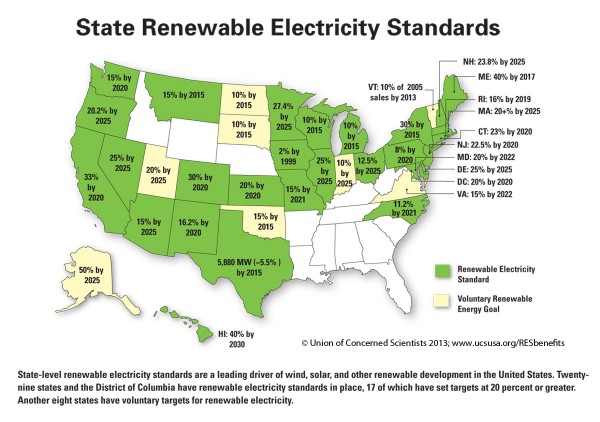Recent efforts to repeal renewable electricity standards (RES) by fossil-fuel backed opponents have been thwarted in Kansas and North Carolina. The reason? As a newly released review of state RES policies by the Union of Concerned Scientists report clearly shows, these popular, bipartisan policies are working effectively all over the country; affordably driving new renewable energy development and delivering substantial economic benefits to states and local communities in the process. Simply put, the facts on the ground are proving difficult to overcome for those seeking to roll back progress toward a clean energy economy.
Driving Renewable Energy Development
The U.S. supply of renewable electricity—including wind, solar, geothermal, and biopower—has been growing at a remarkable pace recently. The wind and solar industries experienced record installations in 2012, and non-hydro renewables now supply more than 5 percent of the total U.S. power supply, up from less than 2 percent in 2007. A key driver of this development is the state RES, which requires electric utilities to gradually increase the amount of renewable energy in their power supplies. Twenty-nine states and the District of Columbia have these market-based policies, 17 of which have set targets of 20 percent or greater. As one of most popular and effective tools for encouraging renewable energy development, RES policies have played a central role in the clean energy success story over the last decade.
According to the Lawrence Berkeley National Laboratory (LBNL), at least 33,000 megawatts (MW) of new renewable capacity—equivalent to about 50 average-sized coal plants—were added in RES states between 1998 and 2011. Today, 9 of the top 10 states in total installed wind capacity, and 17 of the top 20 states in total installed solar PV capacity, have RES policies in place. Looking ahead, state RESs are poised to continue driving renewable energy development and are projected to support at least 87,000 MW of new capacity additions by 2025.
A Good Deal for Consumers
Meeting RES requirements is proving to be an affordable way for utilities to add power-generating capacity while reducing dependence on fossil fuels. In a recent evaluation of RES compliance-cost data available for 14 states, LBNL estimated that all but one state experienced cost impacts of less than 2 percent, with some utilities even reporting consumer savings. For example, renewable energy investments spurred by the Minnesota RES lowered electricity prices for Xcel Energy customers—the state’s largest utility—by 0.7 percent in 2008 to 2009. Xcel also estimated that meeting the RES through 2025 would increase costs by just 1.4 percent.
In Kansas, recent RES-driven development by the state’s two largest utilities, which will put them more than halfway toward meeting their 20 percent by 2020 target, is resulting in a modest 1.7 percent rate increase according to the Kansas Corporate Commission. Compare that actual data with the whopping 45 percent rate increase projected in a bogus study of the Kansas RES by opponents trying to drum up support for their repeal effort.
Delivering a Range of Economic Benefits

The 112-MW Harvest Wind project in Huron County, Michigan, generates enough electricity to supply more than 15,000 local homes while providing an income stream for the community. Landowners who host such facilities receive lease payments of about $8,000 per turbine each year. Source: National Renewable Energy Laboratory
Investments in renewable energy are contributing substantially to economic prosperity nationwide in the form of jobs and income streams for state and local economies. In 2012, more than 119,000 people worked in U.S. solar-related industries and the U.S. wind industry employed 75,000 full-time workers. In fact, the total wind energy workforce includes 30,000 jobs at nearly 500 wind-turbine and components-manufacturing facilities across the country. Renewable energy industries are also supporting good paying jobs in construction, operations, maintenance, engineering, sales, and other services.
In addition, developing renewable energy resources makes good economic sense in communities where projects are sited. For example, government estimates show that wind projects have a county-level annual-earnings impact of $5,000 to $43,000 per installed megawatt. State and local governments also collect property and income taxes and other payments from renewable energy project owners, which are particularly important to rural communities struggling to maintain funding levels for critical services.
Economic success stories from renewable energy investments are evident in every RES state. For example, investments in three wind projects by DTE Energy, Michigan’s largest utility, are contributing $150 million in economic benefits to the state. Michigan is now home to nearly 200 companies that operate in the solar or wind supply chains, supporting more than 10,000 jobs.
The American Wind Energy Association reports that in 2011, Colorado’s wind industry supported 4,000 to 5,000 jobs, made property-tax payments totaling more than $10 million, and paid about $5.4 million in land lease payments.
New Jersey’s RES policy has helped make the state a national leader in solar development, with roughly 20,000 installations and more than 950 MW of installed PV capacity. New Jersey’s largest solar project, a 20-MW facility located in Pilesgrove, alone represented a $90 million investment and created some 200 construction jobs during its development in 2011.
Challenges Ahead

Workers install PV modules on an Englewood, CO, home. Jobs are just one of the economic benefits that come from the increased investment in renewable energy spurred by state renewable electricity standards. Source: National Renewable Energy Laboratory
RES polices have a long history of bipartisan support, yet now one of the most important challenges they face is repeated attacks led by organizations such as the American Legislative Exchange Council, Beacon Hill Institute, and Heritage Foundation, which often receive funding from fossil fuel interests. Fortunately, most of the attacks have been unsuccessful, largely because many policy makers on both sides of the political aisle recognize the diverse and significant benefits that renewable energy development confers on their state economies and local communities.
Efforts to roll back or repeal RES policies are expected to continue, including in North Carolina where RES opponents are now demonstrating they’ll even undermine the political process to try and get their way. But their charge is only going to get harder, as state RES continue to deliver the economic goods and help accelerate the nation’s transition to a cleaner, safer, and more reliable energy future.

